Palo Alto College
History 1302
April 10, 2007
|
Texas Small Town History
Project Palo Alto College | |
|
Ray Montez History 1302 |
Ray Montez April 10, 2007 |
Introduction:
Considering the countless places that I have seen or driven through in Texas, no other place has equaled the small-town charm and sense of history that I felt after I took the time to explore Mason County and the county seat of Mason. A demonstration of this small-town charm was displayed by the county sheriff who was waving at other drivers as he drove along the northern edge of the courthouse square. Mason is located 41 miles to the north-northwest of Fredericksburg, Texas. The town's geographic location serves as the intersecting point for U. S. Highways 87 and 377, State Highway 29, and farm to market roads 1723 and 1871. Mason, and all of Mason County, is known as the gem of the Hill Country because of the abundance of Blue Topaz, the state gemstone.
Origins: In January of 1847, he left Fredericksburg with 20 men and
three wagons to cross the Llano River at the mouth of Beaver Creek and then on
to the future site of Mason. It is thought that the area around Gamel Spring is
where Mr. Meusebach and Chief Ketemoczy met for the first time. Chief Ketemoczy
showed Mr. Meusebach a map and pointed out the nearest road to the San Saba
River where a meeting about a possible peace treaty would take place in a few
days between them and the other head chiefs. Twenty-five miles above the mouth
of the San Saba River into the Colorado River, Mr. Meusebach made a treaty with
the three head chiefs: Buffalo Hump, Santa Anna, and Mopechucope. In exchange
for $3,000 of presents, 3,000,000 acres were relinquished for survey work and
colonization without fear of attacks. 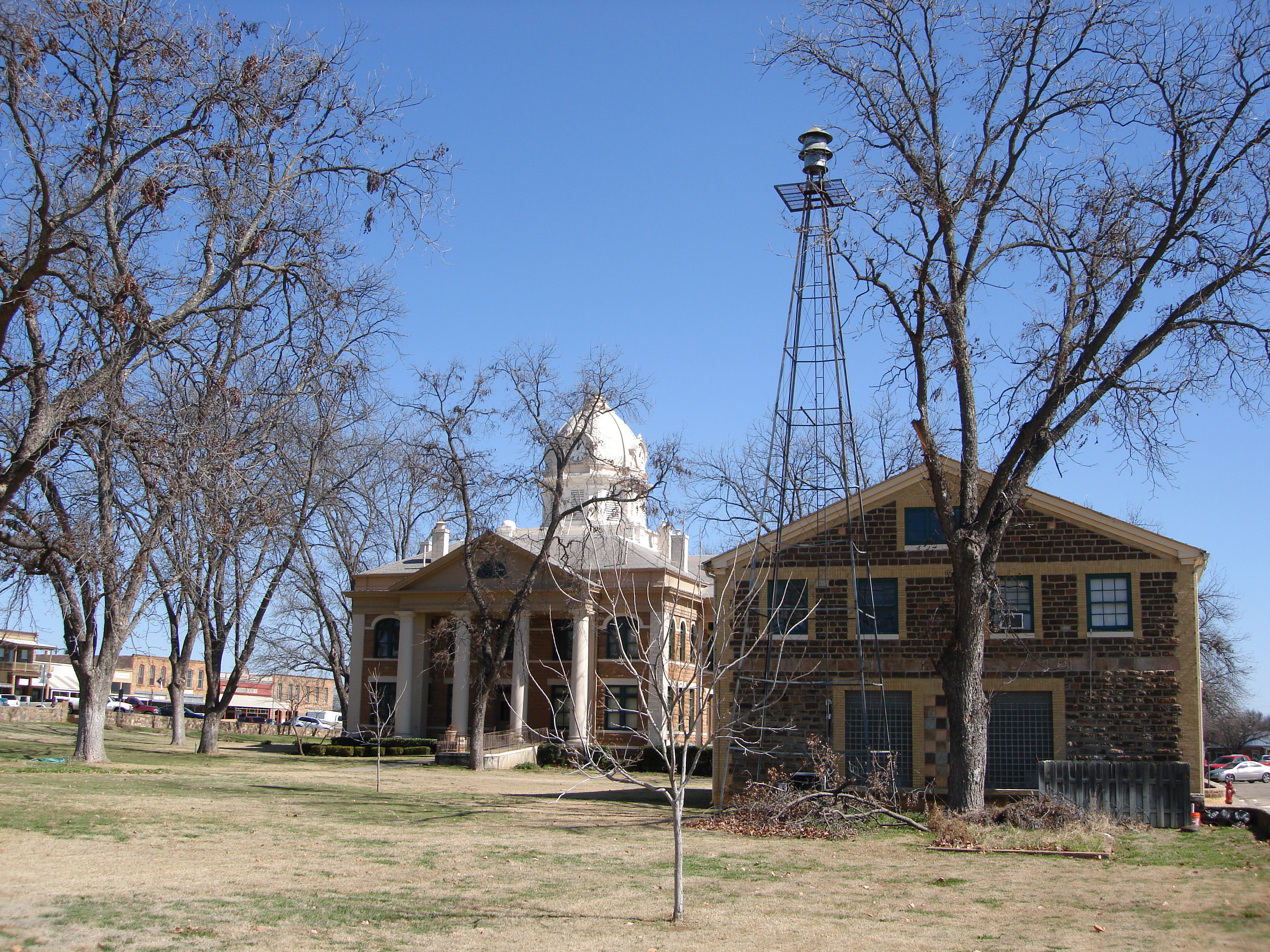
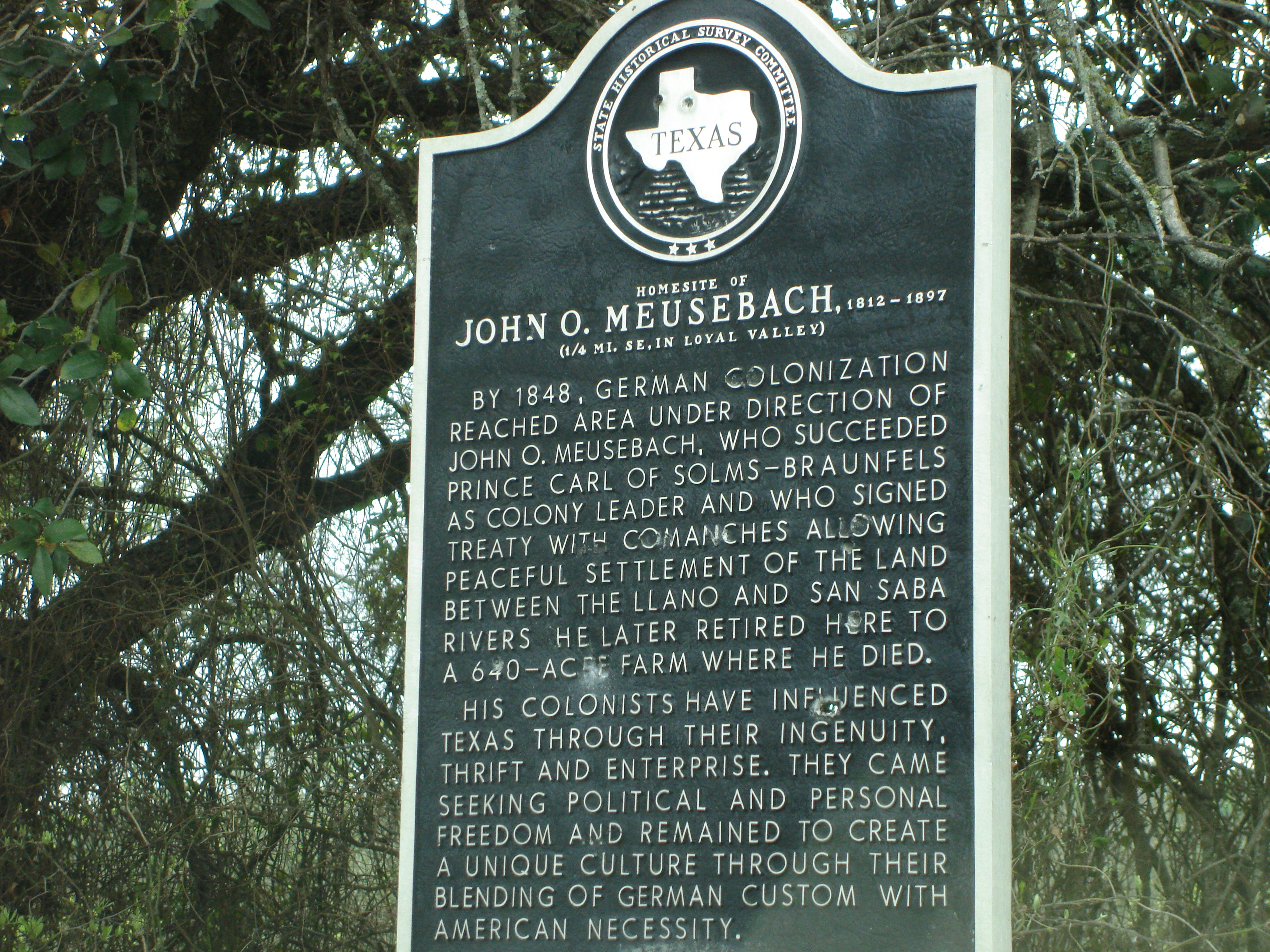 Eventually, the beginning of the end for the Comanches came when
the Fisher and Miller grant, or Colonization Contract, was approved by President
Sam Houston of the Republic of Texas on September 1, 1843. This contract was
sold to the German Emigration Company with John O. Meusebach as not only its
commissioner, but to be later known as the founder of Fredericksburg, Texas.
Eventually, the beginning of the end for the Comanches came when
the Fisher and Miller grant, or Colonization Contract, was approved by President
Sam Houston of the Republic of Texas on September 1, 1843. This contract was
sold to the German Emigration Company with John O. Meusebach as not only its
commissioner, but to be later known as the founder of Fredericksburg, Texas.
General Richard Mason supervised the construction of a line of forts that were built 40 to 50 miles apart to protect settlers from Indian attacks. This line of forts had stretched from the Red River southward to the mouth of the Rio Grande. In my opinion, the fact that he supervised the construction of the forts doesn't signify that he was actually there. According to a History of Mason County, Texas through 1964, page 352, Lieutenant George Mason was stationed in Texas with the 2nd Dragoons between 1845 and 1846. Lieutenant George Mason was killed 25 miles from Brownsville, Texas on April 25, 1846 in what might have been the first skirmish of the Mexican-American War.
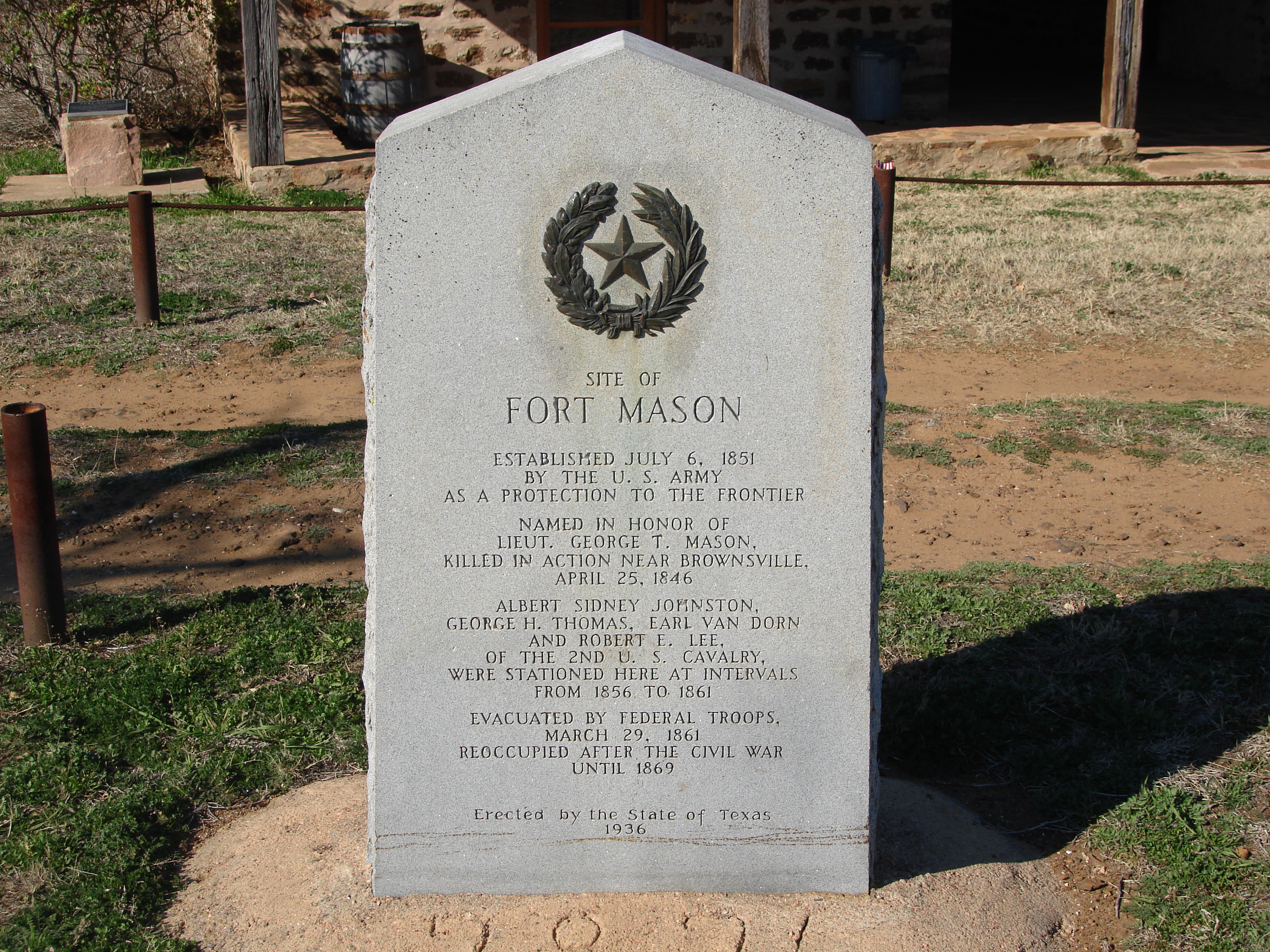
In contradiction with the first paragraph under "founders", it is a general belief that Fort Mason was named in honor of Lieutenant George Mason. Although its history goes back to 1845, official records indicate that Fort Mason wasn't established until July 6, 1851. When it was completed, it consisted of approximately 75 buildings which were constructed of logs, lumber, and native stone that was found in numerous sandstone ledges around Post Hill itself.
Some settlers proved to be braver than others. William S. Cox, historically known as Uncle Billy, settled in the area before Fort Mason was even built. Two brothers and four sisters joined him shortly after. The Jones and Latham families soon followed. George W. Todd was designated to implement the formation of Mason County out of a northern portion of Gillespie County on January 22, 1858. A ranching pioneer named John Gamel donated land on which Mason is now situated. According to page 21 of the book, Mason and Mason County: a History, the following people were sworn in on August 2 of 1858: Chief Justice, John McSween; County Clerk, George W. Todd; Sheriff, Tom Milligan; Tax Assessor, L. Burgdorf; District Clerk, W. C. Lewis; Treasurer, G. F. Weatherby; and Henry Hoerster, J. A. Allen, William Greenwood, H. F. Kiser, and Stephen Peters as the County Commissioners.
The first saw mill and grist mill in Mason were built by John Lemburg and James E. Ranck. James Ranck was a big land owner as well as a successful trader and store owner. His store was in the rear of what is now the Mason National Bank. He is remembered as the father of Mason because of his efforts to bring in settlers and then encouraging them to stay in the area; however, his unending trust in others led to his financial demise. To make matters worse, his uninsured mills had burned down and the price of cattle took a nosedive.
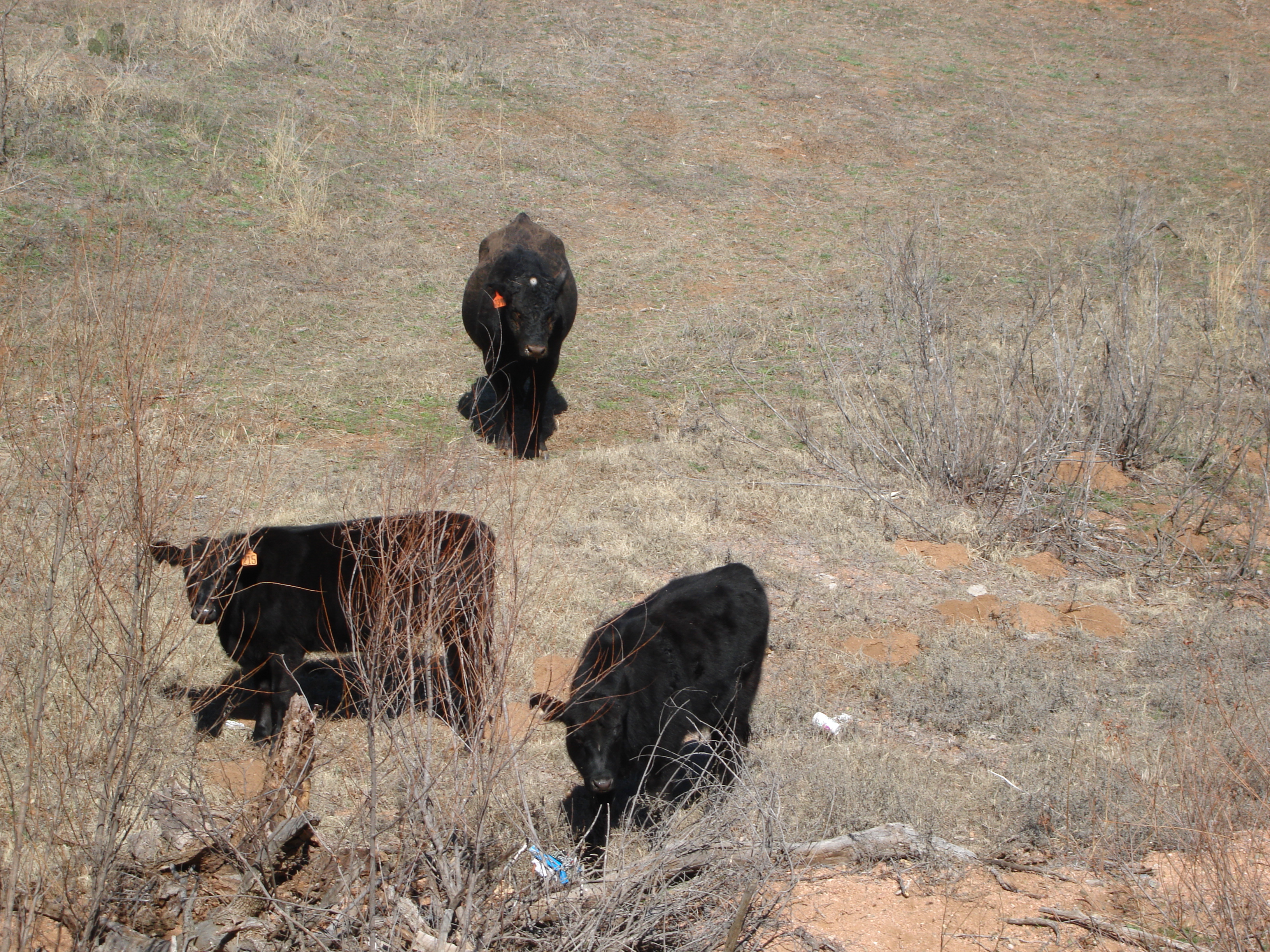
Economy:
The people of Mason have always regarded agriculture and the raising of livestock as vital sources of revenue and food. When the Civil War began, men who made a living by tending to their cattle were quickly called upon to join in the fight; as a result, cattle began to roam free and the result was an enormous increase in their numbers. After the Civil War, the price of cattle meat was so low that they were being killed for their hides. James Ranck's store had become the center of a booming cowhide trade, but it wasn't very long before an increase in demand for beef in the northern and eastern sectors of the United States caused prices to soar. By 1940, large ranches that belonged to the original settlers of Mason County were gradually divided into 906 small ranches. In time, cattlemen developed improved breeds of cattle. Eventually the Hereford and Black Angus breeds replaced the Longhorn.Today, the 4-H club has given a certain level of clout to the ranching industry in Mason. The following passage is from the http://en.wikipedia.org/wiki/4-H web link:
4-H in the United States is a youth organization administered by the Cooperative Extension System of the United States Department of Agriculture (USDA) with the mission of engaging youth to reach their fullest potential while advancing the field of youth development.
By 1860, the principal crops consisted of Indian corn and sweet potatoes. The harvesting of cotton was profitable between 1890 and 1930, and then peaches and pecans were harvested between 1910 and 1950. The peanut industry had been established sometime before the seven years' drought of the 1950s. The people of Mason had weathered previous droughts, but this one was so severe that the only way to maintain any hope of reaping a noticeable harvest was by drilling deep irrigation wells. At the same time, drinking-water needs for the people of Mason were being shifted from private wells to a municipal water system.
Mineral resources such as feldspar, iron, lead, manganese, topaz, and a granite form of quartz exist in small amounts. More abundant natural resources include crushed rock and gravel, sand, and lime.
Today, Mason is recognized as a popular hunting and fishing destination.
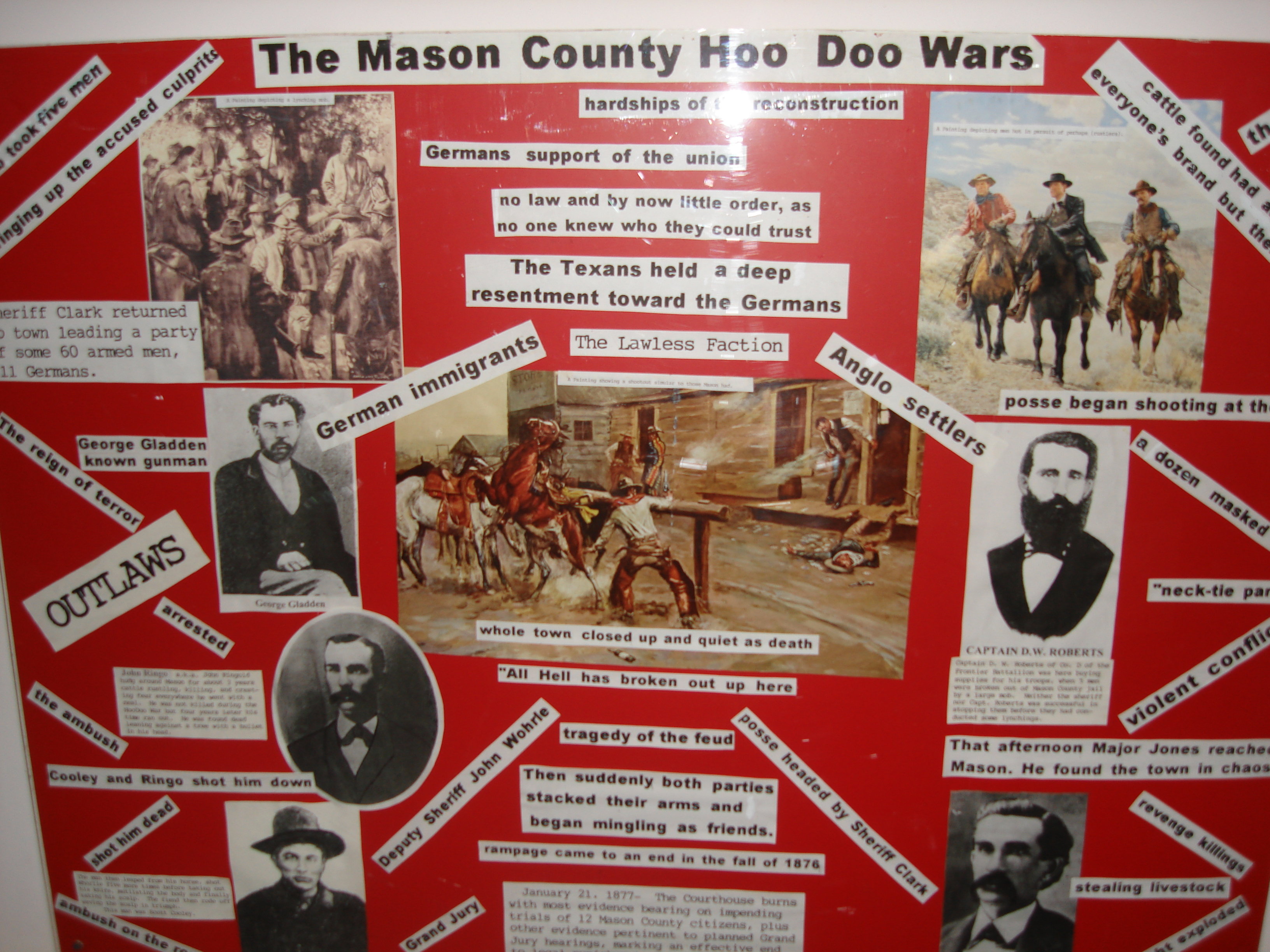
Events:
One might say that the Mason County War reached its peak from 1875 to 1877, but the truth is that hostilities related to this war lasted much longer. It is also known as the Hoo Doo War because of a black person who had supposedly said the following: “Who do it?” The war itself began as a feud over cattle rustling, but the origin can be traced back to the differences between German settlers and American-born people on the issue of Secession from the Union. Out of 77 people who voted on this issue, only two voted to join the Confederacy. Keep in mind that most of these voters were German settlers. These were hard-working, farm-bred people who didn’t rely on slaves. The 1860 census reported that out of a population of 630, only 18 were slaves. Germans and Americans living in and around Mason became opposing factions. This event is noted in C. L. Sonnichsen’s book, Ten Texas Feuds, as one of the worst feuds in Texas history.The war seemed to have started on February 13, 1875 when Sheriff John Clark arrested nine men for stealing cattle. Four of the men escaped before a trial could be held. Sometime between the night of February 17 and very early hours of February 18, a mob of some 40 men outnumbered the sheriff and then took off with the remaining five men. Sheriff Clark gathered a group of men and took off in pursuit. Upon arriving at a place near Hick Springs, he and Captain Dan Roberts found the bodies of the two Baccus cousins and a man named Wiggins along with a hanged, but still alive, Tom Turley. A fifth man named Johnson escaped but had wandered into Captain Roberts’ camp a few days later. Johnson was unable to identify any member of the mob.
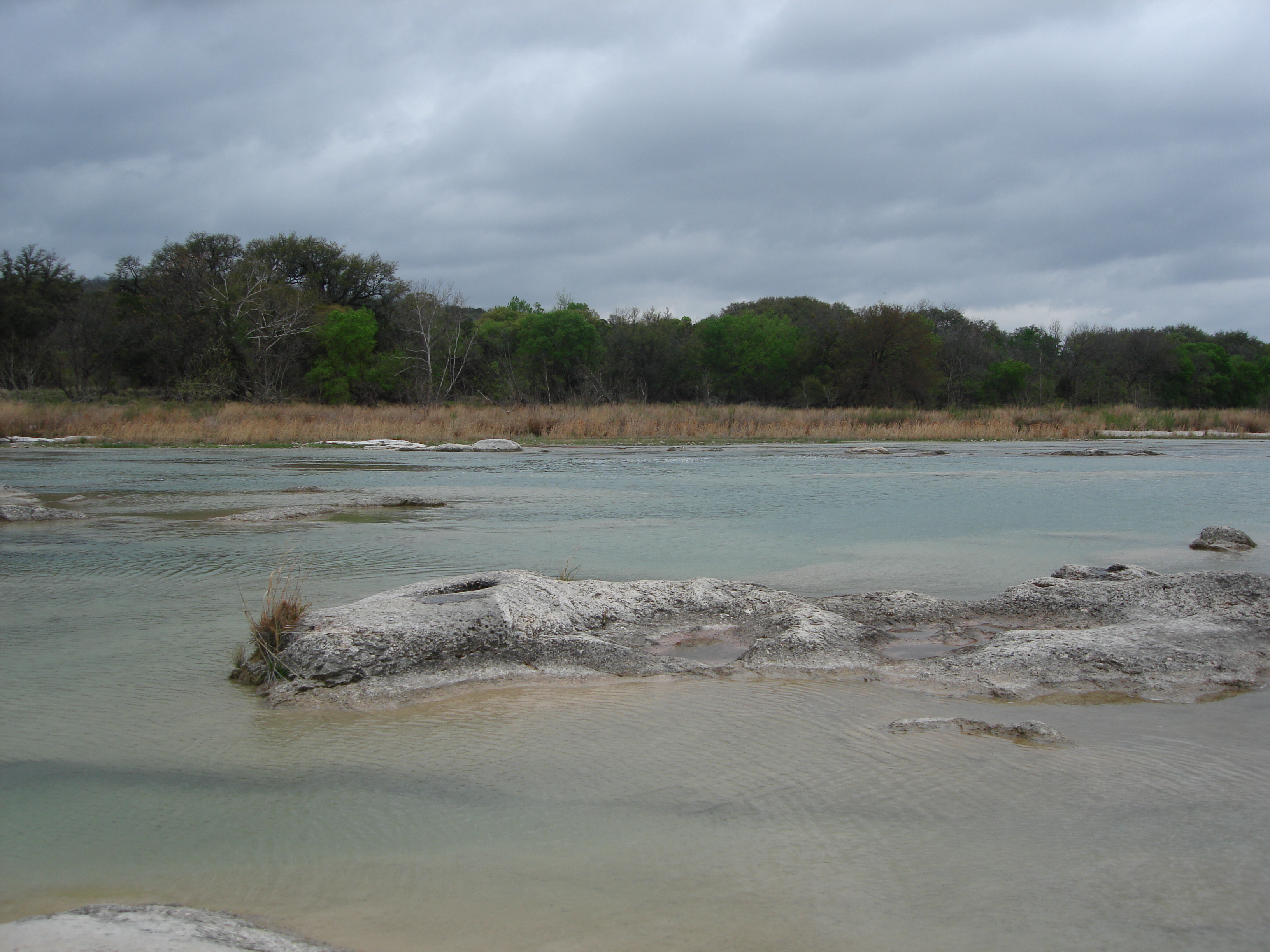
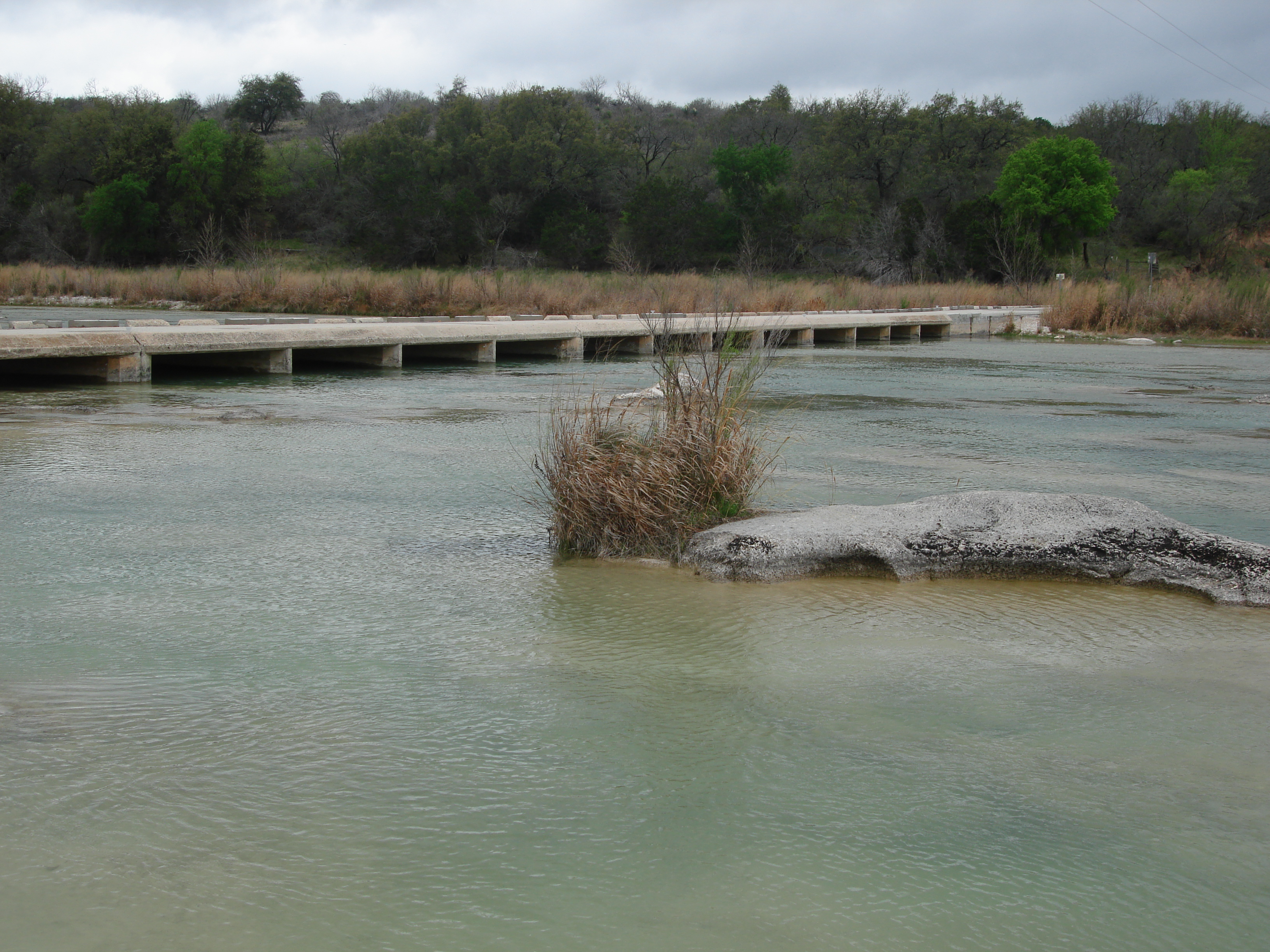
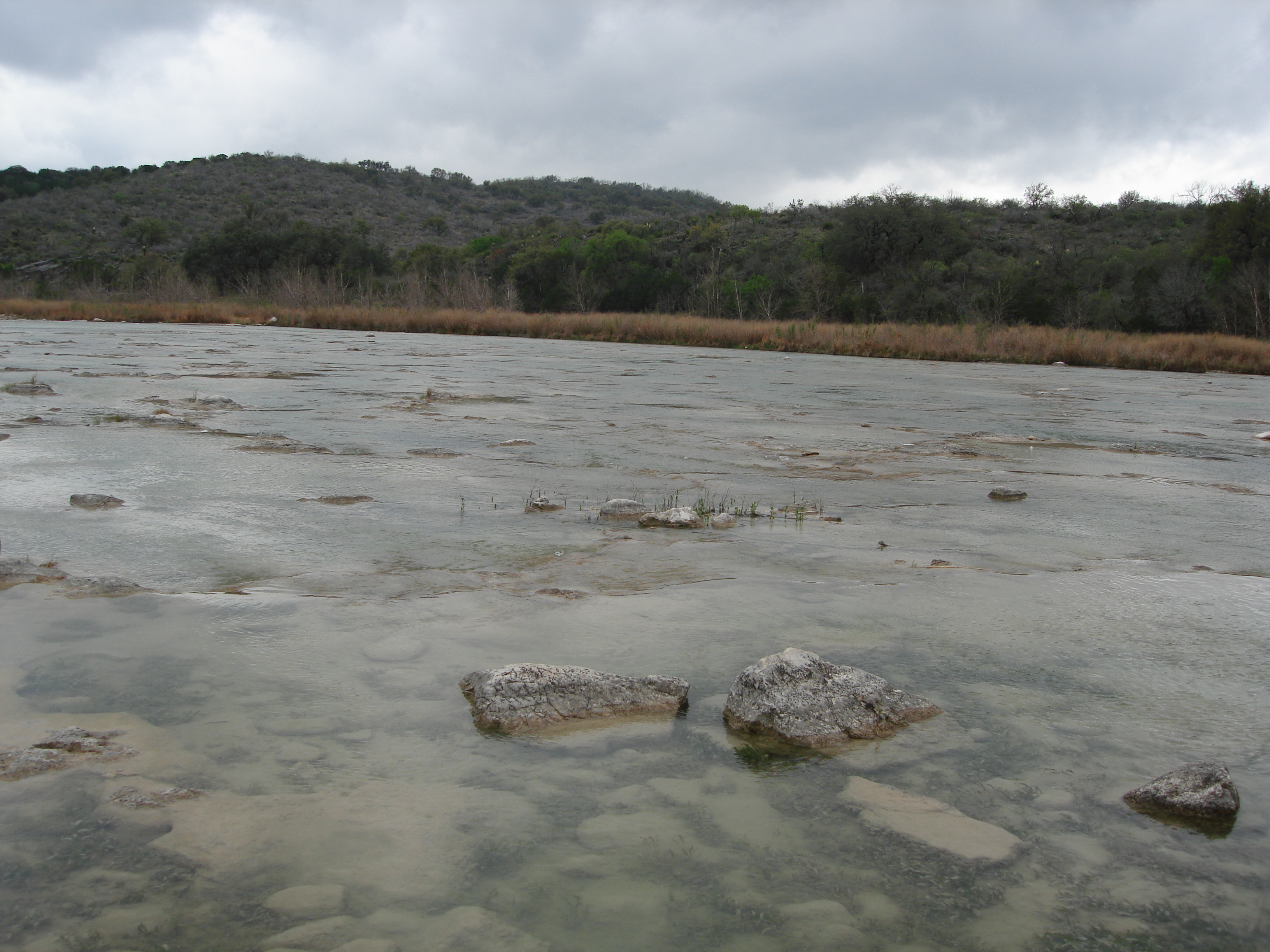
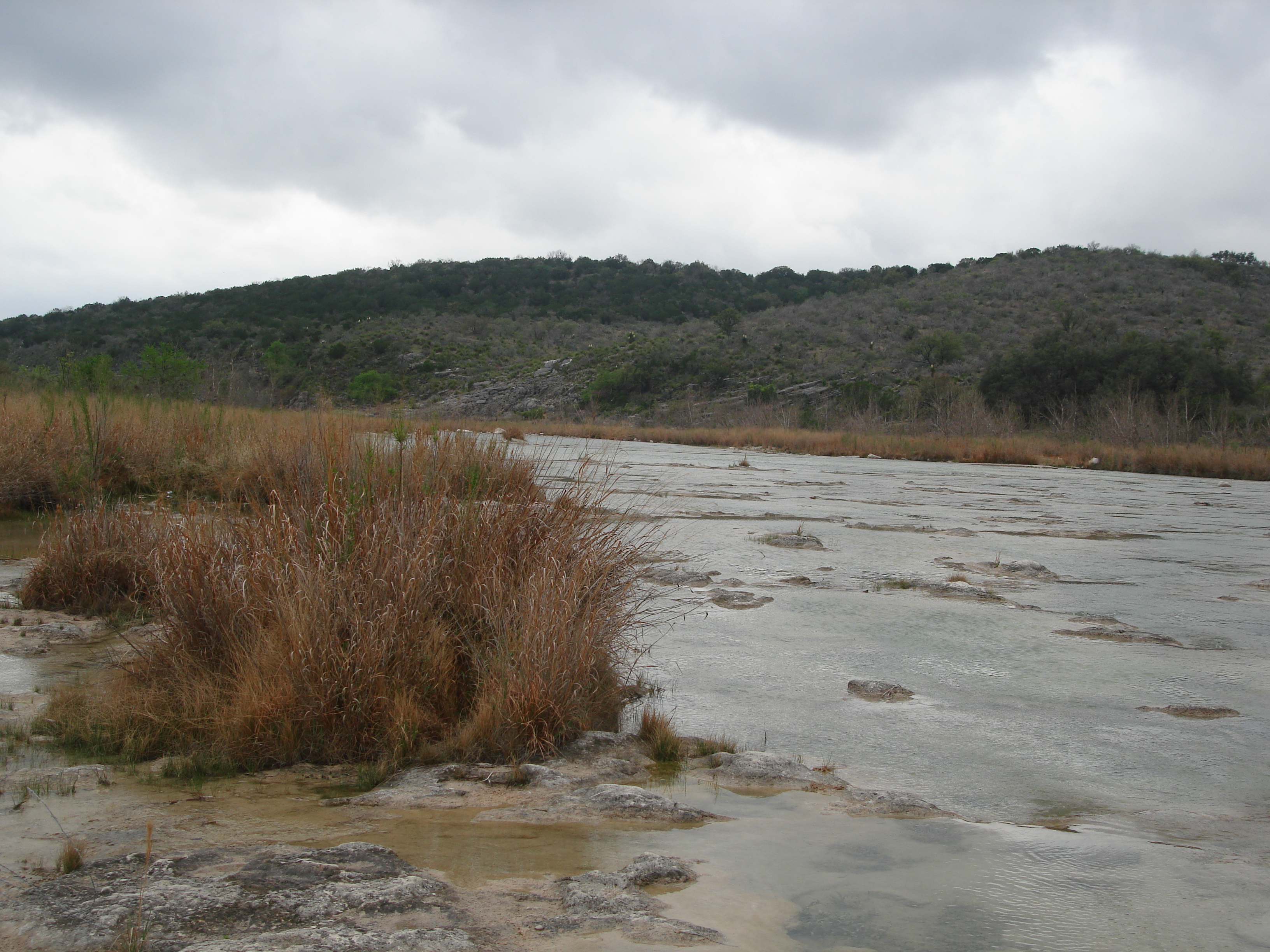
On May 13 of 1875, Sheriff John Clark sent Deputy Sheriff John Worley to arrest Tim Williamson on the charge of stealing cattle. As they headed toward Mason, 12 men had killed an unarmed Tim Williamson. Scott Cooley, a former Ranger and close friend of the Williamson family, vowed to retaliate not only against the gunmen, but also against John Worley for not having sufficiently protected Mr. Williamson. John Beard, Mose Beard, George Gladden, John Ringgold, and a man named Williams joined Cooley’s group and would be connected with at least a dozen killings. While working near his well on August 10, 1875, John Worley was shot in the head and scalped by Scott Cooley. Shortly afterwards, Sheriff Clark rode down to Keller’s store on the Llano River. While there, he saw that the two men who were approaching were Mose Beard and George Gladden. A shootout left Beard and Gladden badly wounded; however, they were able to take off on horseback with the sheriff close behind them. Mose Beard died a short time after the authorities found them, but Gladden recovered from 9 gun shot wounds.
At sometime between the day of the shootout at Keller’s store and September 21 of 1875, a petition by the townspeople was sent to Governor Richard Coke as a request for protection. On September 21, 1875, it is believed that John Ringgold, possibly along with a man named Williams, and several others rode to the home of a Mr. Cheney under the pretense that they were accepting Cheney’s invitation to breakfast. What is known is that Cheney was gunned down at that time.
As ordered by Adjutant General William Steele on authority of the governor, Major John B. Jones went to the Mason area with 20 to 30 men from Company "A" along with an additional ten men from Company "D" of the Texas Rangers. When Major Jones and his group reached Keller’s store, he was met by Sheriff Clark and 15 to 20 heavily armed men who had received warning that the Cooley faction was riding in from Cold Spring to “burn the Dutch out.” After making an investigation, the Major chose to stay in Cold Spring to await further action from either party.
He rode into Mason on September 29, 1875. Upon arrival, he sent scouts in every direction to look for Cooley. After two weeks without success, he discovered that his scouts, as well as most of his men from Companies "A" and "D", were sympathetic and supportive of Cooley’s quest for vengeance and to do away with the Dutch. Major Jones gathered his men and gave a speech with emphasis of their oath to protect the State of Texas against all enemies. He concluded his speech with offering an honorable discharge and a clean slate to every man who wouldn’t pursue Cooley to the bitter end. Nearly 15 men stepped to the front. September 29, 1875, was also the day that Daniel Hoerster was shot to death just as he reached what was known as Hunter’s Hotel but was later named the Southern Hotel. According to the Life of Thomas W. Gamel, Tom Gamel gave the following eye-witnessed account of the murder:
“Dan Hoerster, Peter Jordan and a fellow by the name of Pluenneke were stopped in front of Doole’s store talking with Doole. Clark had been with them but had ridden down the street. Tom Gamel, Mart Moran, and Bill Coke were standing in Tom’s saloon watching to see what was going to happen. Dan Hoerster, Peter Jordan, and Pluenneke rode on toward the old bank building. When they reached the Southern Hotel, they stopped for a minute and had a short conversation with Scott Jones and rode on.”“John Beard and Scott Cooley were behind the barber shop and Dan Hoerster, Peter Jordan and Pluenneke did not come into their view until they reached the lower end of the Southern Hotel; just as they came in sight John Beard and Scott Cooley opened fire. Beard fired from the southwest corner of the barber shop.”
“The barber did not know that Beard and Cooley were behind his shop, and he was sitting in the window in the corner of his shop stropping his razor. When Beard stuck his gun around the corner and fired, the barber cut his strop in two.”
“Dan Hoerster fell from his saddle on the right side of his horse when the first shot was fired, four buck shots hitting him in the neck, from Beard’s gun. Peter Jordan and Pluenneke jumped off their horses and ran around the back of the Southern Hotel and went in. This was about eight o’clock in the morning and there were about eighteen or twenty guests sitting on the porch of the hotel. When the shooting commenced, they all ran inside.”
“At this time, Jim Hunter was operating the Southern Hotel. His daughter Laura was making up a bed in one of the southern exposed rooms. A load of buckshot passed through the window, burying themselves in the walls on the opposite side; the glass from the broken window cut her face.”
“There was a guest stopping at the hotel, from Camp Colorado, on his way to John Gamel’s ranch to transact some business with him. . . .A buckshot passed through the fleshy part of his back but did not penetrate his backbone. After the shooting he asked if anybody there knew John Gamel. “Well,’ he said, ‘when you see him tell him if he wants me to come to Colorado. I am not going down that road another damn step. . . .’”
Some time later, a mob rode to Tom Gamel’s ranch on Mill Creek in search of Tom Gamel and Bill Coke. Mr. Gamel wasn’t home at the time, but Mr. Coke and Gamel’s ranch foreman, Ike Beam, were there. They were arrested and turned over to Sheriff Clark. Although Sheriff Clark provided six men as escorts, Mr. Coke had disappeared and was never seen again. While awaiting trial, Sheriff Clark was placed under guard. He was acquitted at the trial; however, he realized that he just had a close call. In order to avoid a lifetime of looking over his shoulder, he resigned as sheriff and had left Mason for parts unknown. My guess is that he feared that he would end up the same way as John Worley.
It was thought that Major Jones’s presence resulted in a strained peace by the autumn of 1876; however, real peace and respect for the law wasn’t fully restored until the following year. Major Jones designated Lieutenant Long as his successor before being transferred to Coleman in Coleman County.
It was thought that Scott Cooley left the gang and was living with friends in Blanco County where he supposedly died of brain fever shortly after he arrived. Around this time, the Cooley gang raided the Bader place and mistakenly killed Charles Bader instead of their intended victim, Peter Bader. Peter Bader was found and murdered at the Lorenz place in Llano County on January 13, 1876. George Gladden was brought to trial on December 6, 1876 and was convicted of murder in the first degree. He was sentenced to 99 years but was pardoned after only serving a fraction of his sentence. On Sunday, January 21, 1877, arsonists burned the Mason County courthouse to the ground. Nearly every document, including everything pertaining to the feuds, was lost in the fire.
In summary, not a single trial in Mason County resulted in a conviction of murder for any member of any faction that was involved in the “Hoodoo War.”
InterviewRay: How far back does your family tree extend in Mason County?
Jane Hoerster: Three, no, four generations because my grandmother Hofmann came over in the early 1870’s and she brought over two sons and a daughter. They were the first ones to come here. They came here because her sister was living here. Her two sons remained in Mason. They both became merchants. One became a carpenter/undertaker. He was the first undertaker in Mason, and my grandfather Hofmann ended up owning Hofmann Dry Goods which lasted here over a hundred years. He also bought ranches. The other brother centered instead on his building and his mortuary. The Mason Funeral Home was the one that belonged to the Hofmann family. It lasted for over a hundred years. The dry goods store and the mortuary are gone now.
Ray: Ma’am, do you know when the treaty was finalized that allowed the settlement of Mason because I’ve read different things about different meetings that were held between Mr. Meusebach and Chief Ketemoczy. Mr. Meusebach had different meetings with different chiefs, but do you know when the final one was?
Jane Hoerster: Well, I don’t know what year it was. I believe it was 1847, but I’m not sure of that.
Ray: There was supposedly a proposal on the San Saba.
Jane Hoerster: Yes. It was on the San Saba River. The first time that he met with the Indians was here in town. It’s right outside on highway 87. German settlers did not start coming until the 1850’s. It’s very difficult to say who these settlers were. They’re called the German people and the Anglo people. Of course, they’re all Anglos. But the Anglos that came were Scotch-Irish along with some English. The German people started settling along the Llano River. They came into Art which is now located on the Llano Highway. I always felt that Mason was a meeting ground for the different nationalities because the Germans came from Fredericksburg and the others came from other states. It was a meeting ground for the two cultures, so it took a little while to get used to it. My grandmother's name was Brandon, which is Scottish. That family is believed to have come into the Carolinas. Grandfather Valliant's people immigrated into Maryland. Both families were in the States before the American Revolution. The two families drifted into Mississippi, Alabama, and then on to Arkansas. They came to Texas after the Civil War. James Ranck was called the father of Mason. He owned a lot of things here, and he went broke too. He was a bachelor, but he brought members of his family such as his nieces and nephews as well as the Loring and Bridges families. The Bridges built the two-story Mason House that sits on the corner of the square. The Crosby, the Wheeler, and the Gamel families were the big ranchers at that time. Mason became a county in 1858 but it didn’t have a courthouse until after the Civil War. The land that was given by the county seat was down around Comanche Creek. Then after the Civil War, Tom Gamel and his wife as well as W. P. Lockhart and his wife donated the land for the town of Mason. This land included the town square, the school square, and the spring square. The spring square was just up here. The school square was close to the Lutheran church. What really opened up the country was, of course, the building of the forts.
Ray: Can you give me a short version of the Mason County War because from what I’ve read, I couldn’t get a good grasp of the information in a summarizing way.
Jane Hoerster: I don’t think anyone knows. That’s why it’s called the Hoo Doo War. It was happening all over the state, but it was taking a little bit of a different turn in Mason. I think it had something to do with the Civil War because a lot of people say Mason County was against Secession from the Union. I think it had the highest number of votes to stay within the Union. Some people felt that it was that, and there’s always going to be friction between people who don’t quite understand each other. The laws didn’t help matters at that time, and that was another thing that brought it about. Frankly, I think that the Germans had very set ideas about how things should go. They were used to having a lot of government control, not that they wanted it, but they knew what their property was. They cared for it. They didn’t particularly want other people running around on it. Then, of course, were the cattle drives. The first cattle started drifting in from North Texas to the central and southern parts of Texas with the first norther. In the spring, ranchers from the north with their cowboys would come south in the area where their cattle were and start the roundups. Their cattle would have to be separated from the local ranchers' herds. Then both parties drove their cattle to market.
Ray: I’ve heard that it was a short war because it only lasted from 1875 to 1877.
Jane Hoerster: Well, we have people who felt that it lasted a lot longer than that. The German people around here just would not talk about it, and that’s the reason that nothing was known. Llano County was involved in it. This is a criminal docket of the district court of Llano County in the 1870s. You’ll find all kinds of names in here. See, here’s Truitt to Henry Hoerster, the state of Texas, and that’s an indictment. John Clark was our sheriff, and he’s in here for robbery. See, here's Case No. 2711, the State of Texas vs. H. Hoerster--Charge: Purchasing and driving cattle to market without road brand. August 22, 1872. You see, it just started. The records for Mason County burned during that time.
Ray: Yeah, I read about the courthouse burning.
Jane Hoerster: Most courthouses in Texas, I think at that time, burned. The Hoo Doo War was mainly over cattle and then, of course, came the German element as well as the Civil War. Mainly, those were the three things that people talked about. I think that people are going to bond with their culture and their friends which usually are their culture. There were a lot of people who came into Mason County but really didn’t belong here. It was a pretty rough time all the way from the war with Mexico onward because everyone came to Texas. They wanted to get away from everything else. When Germans came into places, there were three things that they had in mind: their family, their schools, and their church. That’s what their lives were centered on.
Ray: Do you know if there was any conflict among the citizens of Mason when the Germans voted to remain part of the Union?
Jane Hoerster: I am not aware of any conflict. It happened in other counties. The Germans didn’t really go along with slavery. It’s not as if some of them didn’t have slaves in certain areas. Slavery wasn’t a way of life over here. Germans who came here came here to stay, but a lot of other people who drifted in had drifted out. I think that made a lot of difference because the Germans prospered. The reasons for this were because of their beliefs in education and church. That’s what you were taught to do.
Jane Hoerster: In Mason, there weren’t many slaves but we do have records of having slaves. We also have slave transaction records. Of course, the Todd family had slaves.
Ray: G. W. Todd?
Jane Hoerster: Yes.
Ray: What is his full name?
Jane Hoerster: George Washington Todd. I think that the Greenwood family had some slaves. Tom Gamel told Daniel Hoerster, “We’ve all done this, so don’t get upset about it. It just happens.” The Germans didn’t think that it should happen.
Ray: Approximately how many blacks are living here now?
Jane Hoerster: We just have Sandy. She’s a descendent of the original black people who came to Mason. Her family sort of comes in and out. At one time, we had quite a few. Before World War II, we had a number of black families. They could do so much better away from Mason, and the war showed them that they could.
Ray: I was at the Crosby Cemetery and had noticed Barrel Cactus plants on some of the very old grave sites that are there. Do they mean anything? Are they growing wild?
Jane Hoerster: It’s probably because they’ve been killed out. I
don’t know.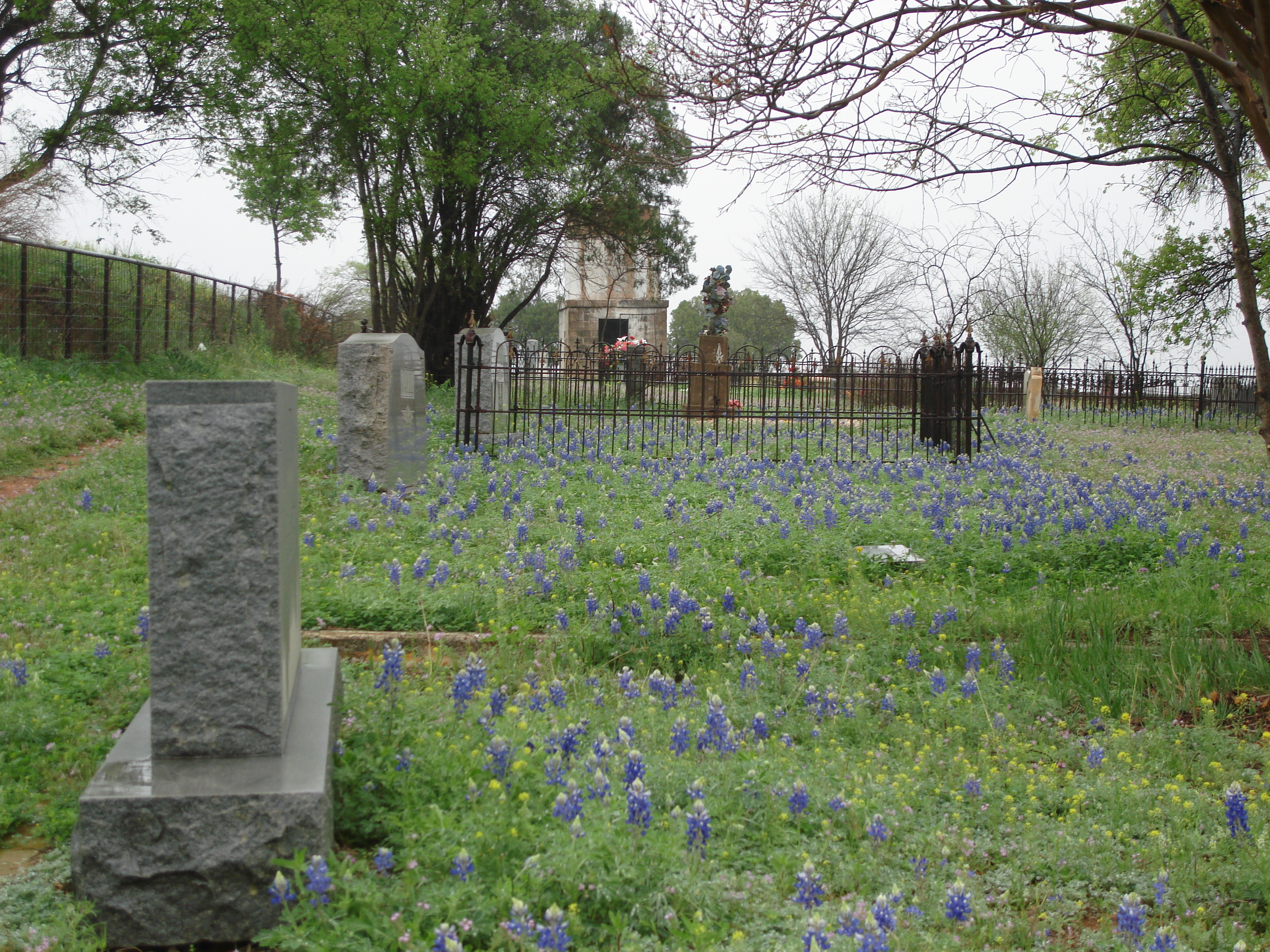
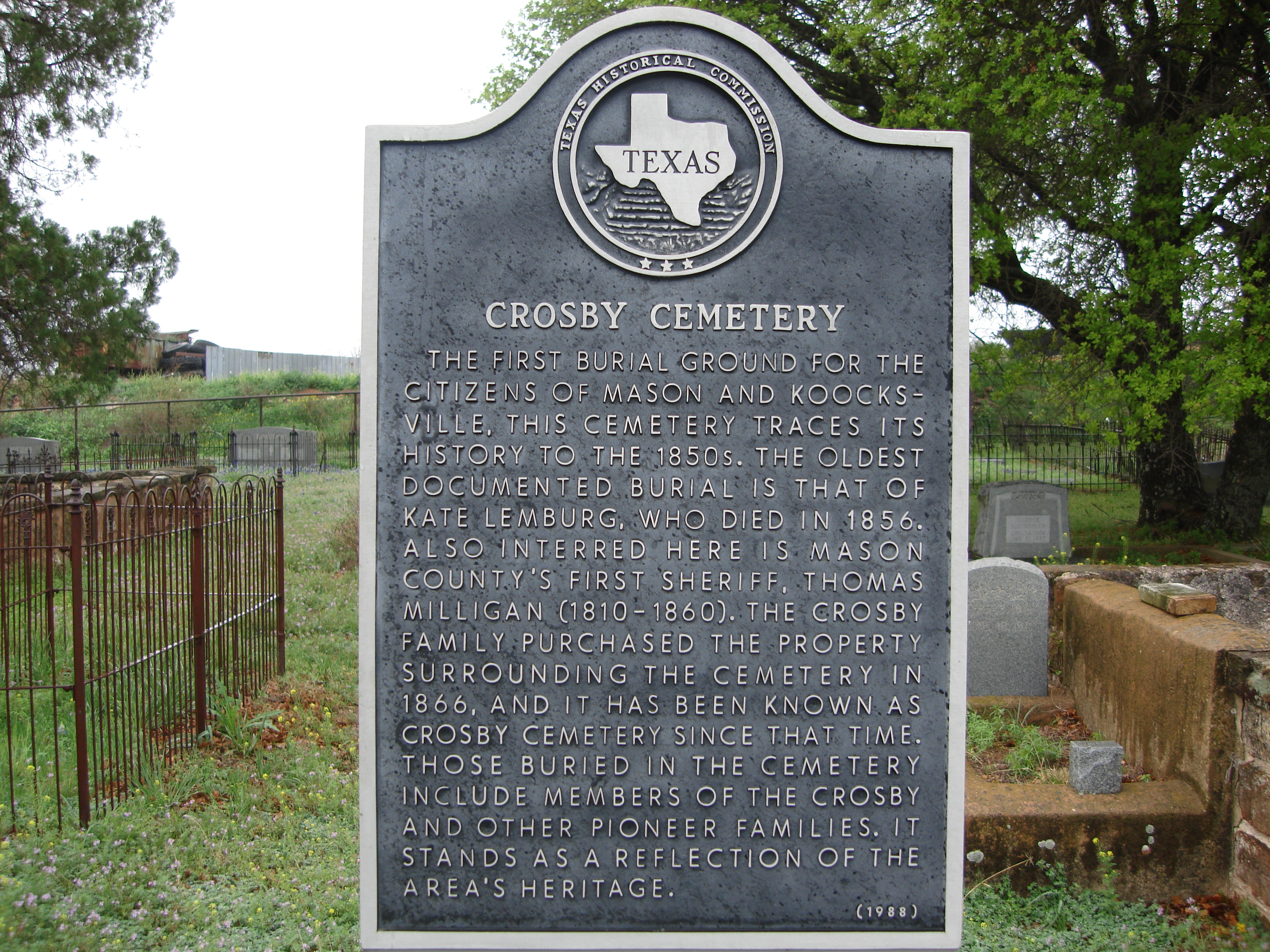
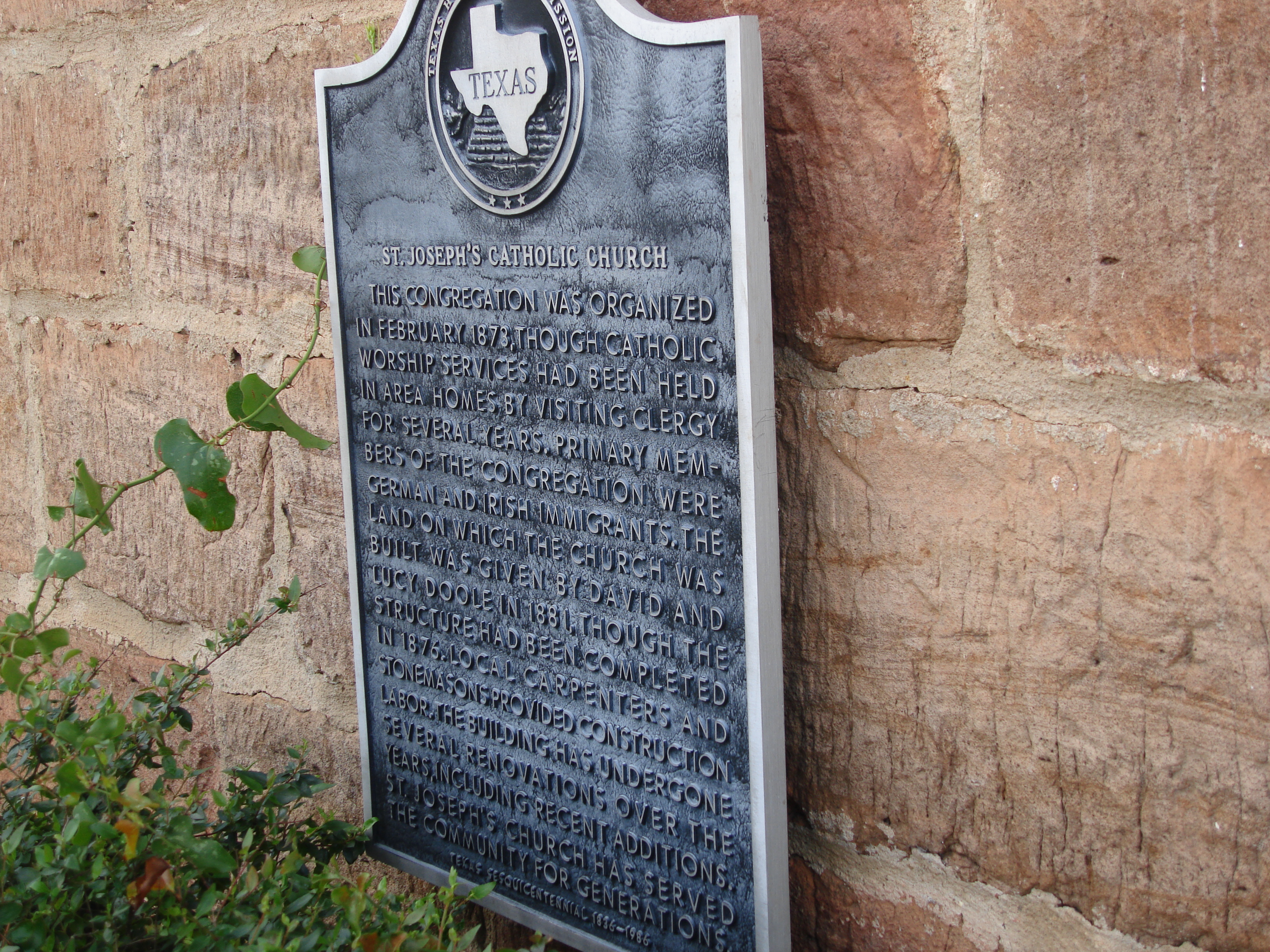
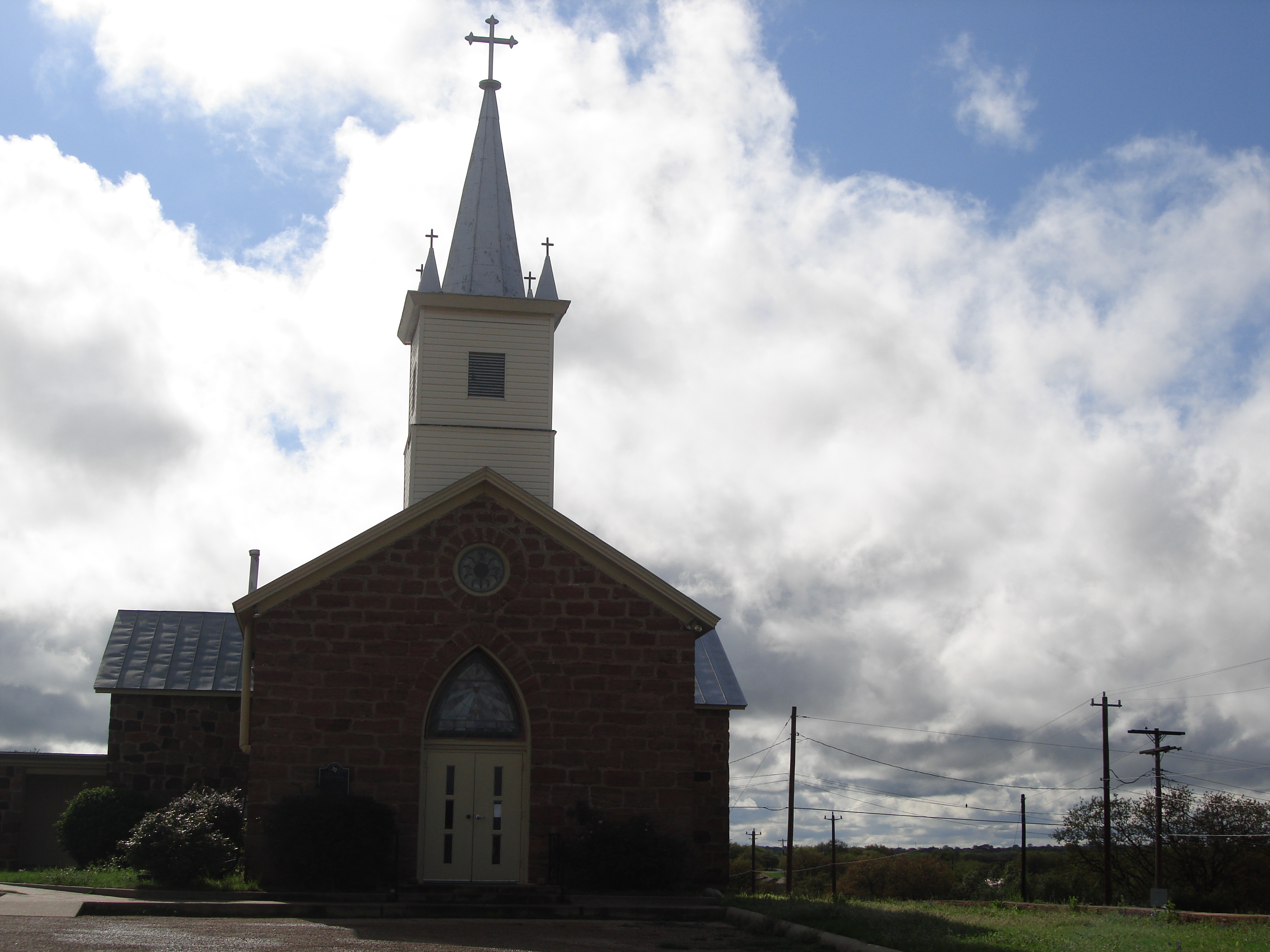
The Crosby family was Catholic. They donated that land. If you noticed, there are all kinds of people buried there. It’s become even more of a Catholic cemetery as the years have gone by. There are a lot of Mexicans buried there and there are even some buried at the Gooch Cemetery.
Ray: Unless I’m mistaken, are most people here Methodist?
Jane Hoerster: Well, you know? Strangely enough, when the German people came, they were either Catholics or Lutherans. The Hoerster and the Kothmann families were all Lutherans, but then they became Methodists.
Ray: What exactly is that concrete tower at the Crosby Cemetery?
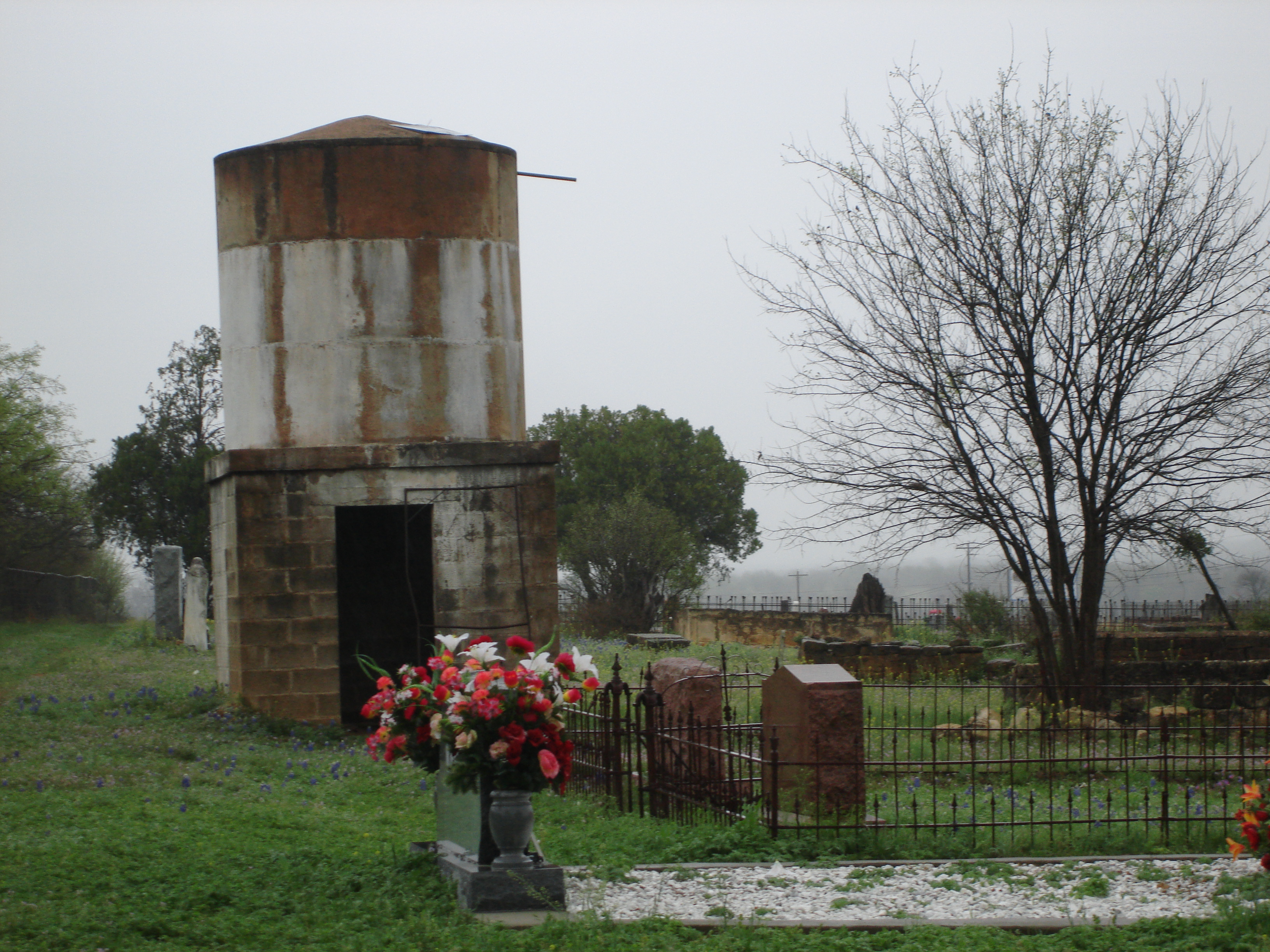
Jane Hoerster: That is called a tank house. It gave the water some height so that it could run. Homes used those tank houses to store vegetables and even milk because the temperature was much cooler inside the tank house. There are troughs that you could run water through.
Ray: It’s not exactly like the concrete tower that I saw at the Seaquist Mansion, is it?
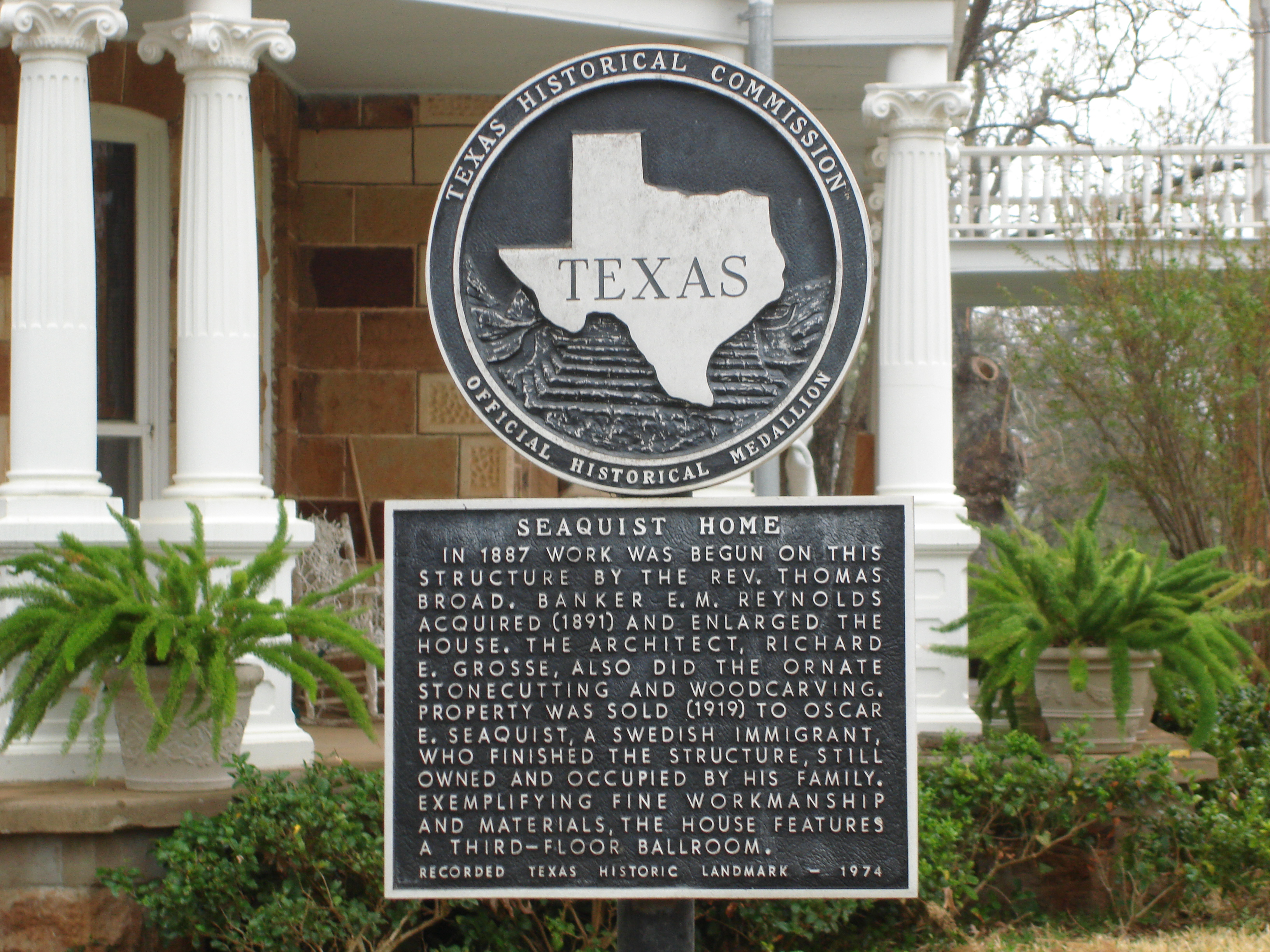
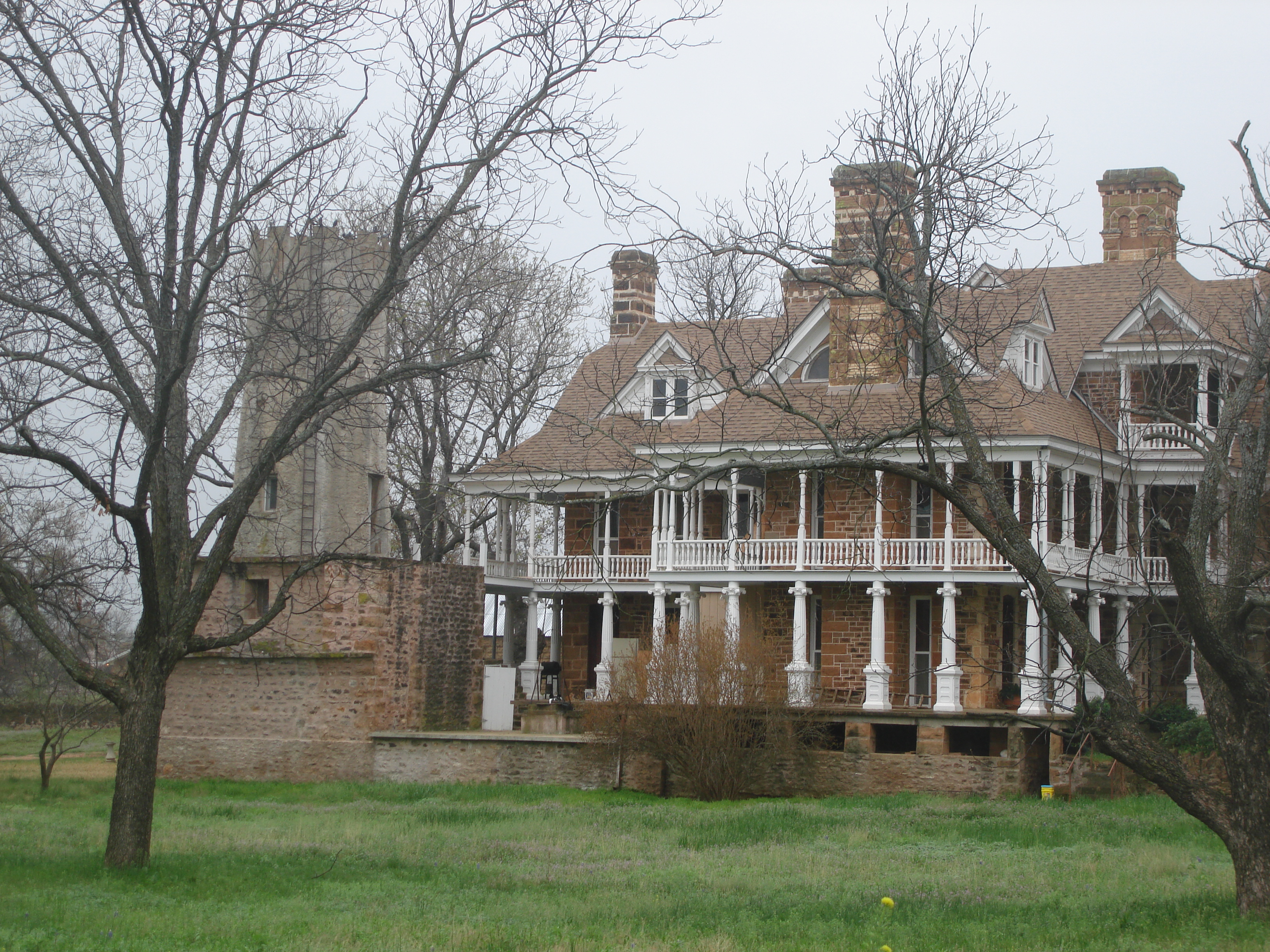
Jane Hoerster: Well, they’re built differently. Some are square, but a lot of them are round. Mr. Seaquist had a room with a fireplace down there that someone could have lived in. It could have been a room for a servant, but he also used it as a workshop.
Ray: Do you know why Mason has remained small and charming while Fredericksburg has exploded into a tourist trap?
Jane Hoerster: First, let me say that we don’t want to become like Fredericksburg. Fredericksburg saved everything. They have a lot of things. Those homes down there are more beautiful that they have ever been. They have a lot of very old homes and Mason doesn’t. At one time, close to 6,000 people lived here, with most of them living out in the country.
Ray: Is there is high percentage of high school graduates or college graduates that remain or return to Mason?
Jane Hoerster: There was a time when they all returned. Today, the percentage of those who return isn’t very high at all.
Ray: For posterity, is there anything that I haven’t asked which you believe people should know about Mason?
Jane Hoerster: I would like for Mason, in many ways, to stay the same. You know, I was amazed one time when I had asked Mr. Marshall why he came to Mason. I sat there for 30 minutes while he told me why he came to Mason and I think it would be a good point. One reason is that you can still write a counter-check. Another reason is that you can still make an agreement with a handshake; and of course, he came here because he likes the people and the atmosphere. He said, “We have been watching Mason for 20 years, and that’s the reason why we came to Mason.”
Conclusion:
I may not be working toward a degree in history; furthermore, I have devoted far more time to my researh that I have devoted to my chosen field of study. However, I must state that I have thoroughly enjoyed working on this particular project. It would have been impossible to complete this project if it were not for everyone who has supported me in my efforts.If you plan to visit a shopping center in the country, you need not go any further than Fredericksburg. If you want to experience what it is really like to be in the country, take the time to drive an extra half hour north on U. S. Higway 87 toward the gem of the Hill Country.
Annotated BibliographyMason Chamber of Commerce. 2006-2007 Mason County & City Maps, Tourist & Visitor Guide, Newcomer's Guide, Attractions, and Business Directory. Courtesy of Texas Trails. I used this brochure/map to familiarize myself with the layout of the town. I also used it to find out which state highways and farm to market roads intersect or completely pass through Mason.
Mason and Mason County: a History by Stella Gipson Polk. For such a small book, this book was worth its weight in gold in regards to my using it to compare the enclosed information with a History of Mason County, Texas through 1964 by Margaret Biercshwale.
A History of Mason County, Texas through 1964 by Margaret Biercshwale. I had to drive into Mason to see this book but it is an extremely detailed source of statistical and historical information. It also contains the following sections which seem to resemble eye-witnessed accounts and/or journal entries.
Pages 68-74 of The Jumano Indians in Texas by Herbert E. Bolton as found on page 294 of A History of Mason County, Texas through 1964 by Margaret Beircshwale.Page 61 of The Texas Almanac 1956-1957 as found on page 294 of A History of Mason County, Texas through 1964 by Margaret Biercshwale. This source contains a map of the Indian tribes of Texas.
Pages 27 and 28 of the Life of Thomas W. Gamel by Lucia Holmes, "Diary." The mentioning of this source is found on page 140 of A History of Mason County, Texas through 1964 by Margaret Biercshwale.
Pages 100 and 101 of Sonnichsen's Ten Texas Feuds as found on page 140 of A History of Mason County, Texas through 1964 by Margaret Biercshwale.
The New Hanbook of Texas, Volume 4 by the Texas State Historical Commission. This is a much better source than the online version because of the sheer size of each volume. I used this book in tandem with my first two sources in order to eliminate contradicting information. I used it as an alternate method of getting my facts straight.
"The Handbook of Texas Online". I didn't have much use for this source because I found everything that I needed in the six volumes of hardcover books at the Palo Alto College library.
Wikipedia in English. http://en.wikipedia.org/wiki/4-H. I needed this source because a young girl from Mason had won a large cash prize at this year's San Antonio livestock show and rodeo. I wanted to find some basic information about the "4-H Club."
I cannot give enough thanks to Mrs. Hoerster. She's also known as Jane Hoerster. She has lived her entire life in Mason County. She has been the Chairperson of the Mason County Historical Commission for the last 25 years. Thank you for giving me your time and your input on the construction and editing of this research project. I can only hope that I have completed a job worthy enough of representing a version of the multi-faceted history of Mason.
Mason, Texas